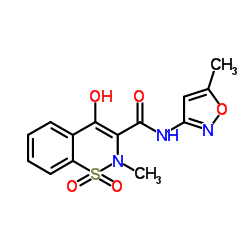Metabolic disposition of the non-steroidal anti-inflammatory agent isoxicam in man.
T F Woolf, A Black, A Sedman, T Chang
Index: Eur. J. Drug Metab. Pharmacokinet. 17(1) , 21-7, (1992)
Full Text: HTML
Abstract
The metabolic fate of isoxicam, a long half-life non-steroidal anti-inflammatory agent, in human subjects was investigated using isoxicam labelled with 14C in the N-methyl position. Three healthy male subjects were each administered a single oral 200 mg dose (90.7 microCi) with plasma and urine collected. Total plasma radioactivity peaked between 8 and 24 h postdose with mean 14C plasma radioactivity half-life of 36.1 h. Low levels of plasma radioactivity precluded plasma metabolic profiling. In urine, 37% of the administered radioactivity was recovered through 168 h. Metabolic profiling of urine confirmed the major oxidative excretion product as the hydroxymethylisoxazole metabolite. Identified and confirmed as minor urinary metabolites were radiolabelled open-ring sulfonamide and N-methylsaccharin. Non-labelled saccharin formed by oxidative loss of the 14C N-methyl group from N-methylsaccharin, was also observed. The role of this 'saccharin pathway' in the overall human disposition of isoxicam remains to be elucidated.
Related Compounds
| Structure | Name/CAS No. | Molecular Formula | Articles |
|---|---|---|---|
 |
Isoxicam
CAS:34552-84-6 |
C14H13N3O5S |
|
Effect of some new prostaglandin synthetase inhibitors on th...
1988-04-01 [Res. Commun. Chem. Pathol. Pharmacol. 60(1) , 19-25, (1988)] |
|
[The effect of estro-progesterones on the inflammatory episo...
1989-10-01 [Rev. Rhum. Mal. Osteoartic. 56(10) , 709-11, (1989)] |
|
Controlled-release naproxen compared with isoxicam in patien...
1988-01-01 [Curr. Med. Res. Opin. 11(1) , 28-33, (1988)] |
|
In vivo metabolism of isoxicam in rats, dogs, and monkeys.
1989-01-01 [Drug Metab. Dispos. 17(6) , 662-8, (1989)] |
|
Liquid chromatography-tandem mass spectrometry method for th...
2009-04-01 [Bioanalysis 1(1) , 63-70, (2009)] |